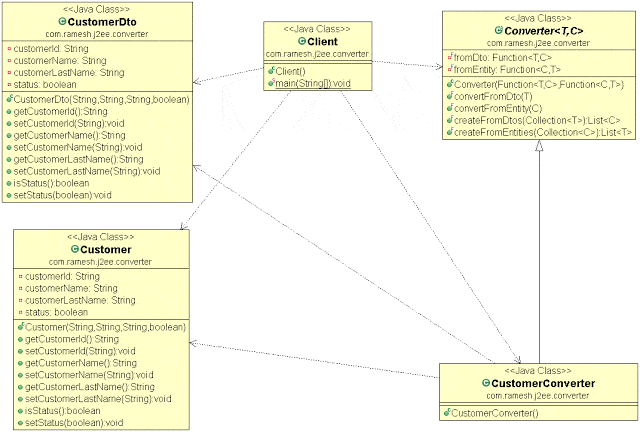жӮЁеҘҪпјҢзҷ»еҪ•еҗҺжүҚиғҪдёӢи®ўеҚ•е“ҰпјҒ
иҝҷзҜҮж–Үз« дё»иҰҒд»Ӣз»ҚдәҶJavaдёӯиҪ¬жҚўеҷЁи®ҫи®ЎжЁЎејҸзҡ„дҪңз”ЁжҳҜд»Җд№ҲпјҢдәҝйҖҹдә‘е°Ҹзј–и§үеҫ—дёҚй”ҷпјҢзҺ°еңЁеҲҶдә«з»ҷеӨ§е®¶пјҢд№ҹз»ҷеӨ§е®¶еҒҡдёӘеҸӮиҖғпјҢдёҖиө·и·ҹйҡҸдәҝйҖҹдә‘е°Ҹзј–жқҘзңӢзңӢеҗ§пјҒ
Javaдё»иҰҒеә”з”ЁдәҺпјҡ1. webејҖеҸ‘пјӣ2. AndroidејҖеҸ‘пјӣ3. е®ўжҲ·з«ҜејҖеҸ‘пјӣ4. зҪ‘йЎөејҖеҸ‘пјӣ5. дјҒдёҡзә§еә”з”ЁејҖеҸ‘пјӣ6. JavaеӨ§ж•°жҚ®ејҖеҸ‘пјӣ7.жёёжҲҸејҖеҸ‘зӯүгҖӮ
зӣ®зҡ„
иҪ¬жҚўеҷЁи®ҫи®ЎжЁЎејҸзҡ„зӣ®зҡ„жҳҜдёәзӣёеә”зұ»еһӢд№Ӣй—ҙзҡ„еҸҢеҗ‘иҪ¬жҚўжҸҗдҫӣдёҖз§ҚйҖҡз”Ёзҡ„ж–№ејҸпјҢе…Ғи®ёзұ»еһӢж— йңҖеҪјжӯӨдәҶи§Јзҡ„з®ҖжҙҒзҡ„е®һзҺ°гҖӮжӯӨеӨ–пјҢиҪ¬жҚўеҷЁи®ҫи®ЎжЁЎејҸеј•е…ҘдәҶеҸҢеҗ‘收йӣҶжҳ е°„пјҢе°Ҷж ·жқҝд»Јз ҒеҮҸе°‘еҲ°жңҖе°ҸгҖӮ
жәҗд»Јз Ғ
иҪ¬жҚўеҷЁи®ҫи®ЎжЁЎејҸжҳҜдёҖз§ҚиЎҢдёәи®ҫи®ЎжЁЎејҸпјҢе…Ғи®ёеңЁзӣёеә”зұ»еһӢпјҲеҰӮDTOе’ҢйҖ»иҫ‘еҗҢжһ„зұ»еһӢзҡ„еҹҹиЎЁзӨәпјүд№Ӣй—ҙиҝӣиЎҢеҸҢеҗ‘иҪ¬жҚўгҖӮжӯӨеӨ–пјҢиҜҘжЁЎејҸиҝҳеј•е…ҘдәҶдёҖз§ҚеңЁзұ»еһӢд№Ӣй—ҙиҪ¬жҚўеҜ№иұЎйӣҶеҗҲзҡ„йҖҡз”Ёж–№жі•гҖӮ
зұ»еӣҫ

и®©жҲ‘д»¬ж №жҚ®дёҠйқўзҡ„зұ»еӣҫзј–еҶҷжәҗд»Јз ҒгҖӮ
еңЁжң¬дҫӢдёӯпјҢжҲ‘们е°ҶжҠҠcustomerdиҪ¬жҚўдёәcustomerе®һдҪ“пјҢеҸҚд№ӢдәҰ然пјҢжҲ‘们иҝҳе°ҶеңЁзұ»еһӢд№Ӣй—ҙиҪ¬жҚўеҜ№иұЎйӣҶеҗҲгҖӮ
жӯҘйӘӨ1пјҡи®©жҲ‘们еҲӣе»әдёҖдёӘйҖҡз”ЁиҪ¬жҚўеҷЁгҖӮ
public abstract class Converter < T, C > {
private final Function < T,
C > fromDto;
private final Function < C,
T > fromEntity;
/**
* @param fromDto
* Function that converts given dto entity into the domain
* entity.
* @param fromEntity
* Function that converts given domain entity into the dto
* entity.
*/
public Converter(final Function < T, C > fromDto, final Function < C, T > fromEntity) {
this.fromDto = fromDto;
this.fromEntity = fromEntity;
}
/**
* @param customerDto
* DTO entity
* @return The domain representation - the result of the converting function
* application on dto entity.
*/
public final C convertFromDto(final T customerDto) {
return fromDto.apply(customerDto);
}
/**
* @param customer
* domain entity
* @return The DTO representation - the result of the converting function
* application on domain entity.
*/
public final T convertFromEntity(final C customer) {
return fromEntity.apply(customer);
}
/**
* @param dtoCustomers
* collection of DTO entities
* @return List of domain representation of provided entities retrieved by
* mapping each of them with the conversion function
*/
public final List < C > createFromDtos(final Collection < T > dtoCustomers) {
return dtoCustomers.stream().map(this::convertFromDto).collect(Collectors.toList());
}
/**
* @param customers
* collection of domain entities
* @return List of domain representation of provided entities retrieved by
* mapping each of them with the conversion function
*/
public final List < T > createFromEntities(final Collection < C > customers) {
return customers.stream().map(this::convertFromEntity).collect(Collectors.toList());
}
}жӯҘйӘӨ2пјҡи®©жҲ‘们еҲӣе»әдёҖдёӘз®ҖеҚ•е®ўжҲ·иҪ¬жҚўеҷЁзҡ„е®һзҺ°гҖӮ
public class CustomerConverter extends Converter<CustomerDto, Customer> {
public CustomerConverter() {
super(customerDto -> new Customer(customerDto.getCustomerId(), customerDto.getCustomerName(),
customerDto.getCustomerLastName(), customerDto.isStatus()),
customer -> new CustomerDto(customer.getCustomerId(), customer.getCustomerName(),
customer.getCustomerLastName(), customer.isStatus()));
}
}жӯҘйӘӨ3: еҲӣе»әcustomerdtoзұ»гҖӮ
public class CustomerDto {
private String customerId;
private String customerName;
private String customerLastName;
private boolean status;
public CustomerDto(String customerId, String customerName, String customerLastName, boolean status) {
super();
this.customerId = customerId;
this.customerName = customerName;
this.customerLastName = customerLastName;
this.status = status;
}
public String getCustomerId() {
return customerId;
}
public void setCustomerId(String customerId) {
this.customerId = customerId;
}
public String getCustomerName() {
return customerName;
}
public void setCustomerName(String customerName) {
this.customerName = customerName;
}
public String getCustomerLastName() {
return customerLastName;
}
public void setCustomerLastName(String customerLastName) {
this.customerLastName = customerLastName;
}
public boolean isStatus() {
return status;
}
public void setStatus(boolean status) {
this.status = status;
}
}жӯҘйӘӨ4: еҲӣе»әCustomerе®һдҪ“зұ»гҖӮ
public class Customer {
private String customerId;
private String customerName;
private String customerLastName;
private boolean status;
public Customer(String customerId, String customerName, String customerLastName, boolean status) {
super();
this.customerId = customerId;
this.customerName = customerName;
this.customerLastName = customerLastName;
this.status = status;
}
public String getCustomerId() {
return customerId;
}
public void setCustomerId(String customerId) {
this.customerId = customerId;
}
public String getCustomerName() {
return customerName;
}
public void setCustomerName(String customerName) {
this.customerName = customerName;
}
public String getCustomerLastName() {
return customerLastName;
}
public void setCustomerLastName(String customerLastName) {
this.customerLastName = customerLastName;
}
public boolean isStatus() {
return status;
}
public void setStatus(boolean status) {
this.status = status;
}
}жӯҘйӘӨ5: зҺ°еңЁпјҢи®©жҲ‘们йҖҡиҝҮеҲӣе»әClientзұ»жқҘжөӢиҜ•иҝҷдёӘжЁЎејҸгҖӮ
public class Client {
/**
* Program entry point
*
* @param args command line args
*/
public static void main(String[] args) {
Converter < CustomerDto, Customer > CustomerConverter = new CustomerConverter();
CustomerDto dtoCustomer = new CustomerDto("100", "Ramesh", "Fadatare", true);
Customer Customer = CustomerConverter.convertFromDto(dtoCustomer);
System.out.println("Entity converted from DTO:" + Customer);
List < Customer > customers = new ArrayList < > ();
customers.add(new Customer("100", "Ramesh2", "Fadatare", true));
customers.add(new Customer("200", "Ramesh3", "Fadatare", true));
customers.add(new Customer("300", "Ramesh4", "Fadatare", true));
customers.forEach(System.out::println);
customers.forEach((customer) - > System.out.println(customer.getCustomerId()));
System.out.println("DTO entities converted from domain:");
List < CustomerDto > dtoEntities = CustomerConverter.createFromEntities(customers);
dtoEntities.forEach(System.out::println);
dtoEntities.forEach((customer) - > System.out.println(customer.getCustomerId()));
}
}иҫ“еҮәпјҡ
Entity converted from DTO:com.ramesh.j2ee.converter.Customer@87aac27
com.ramesh.j2ee.converter.Customer@1b28cdfa
com.ramesh.j2ee.converter.Customer@eed1f14
com.ramesh.j2ee.converter.Customer@7229724f
100
200
300
DTO entities converted from domain:
com.ramesh.j2ee.converter.CustomerDto@4dd8dc3
com.ramesh.j2ee.converter.CustomerDto@6d03e736
com.ramesh.j2ee.converter.CustomerDto@568db2f2
100
200
300
йҖӮз”ЁжҖ§
еңЁд»ҘдёӢжғ…еҶөдёӢ дҪҝз”ЁиҪ¬жҚўеҷЁжЁЎејҸпјҡ
еҪ“жӮЁжӢҘжңүйҖ»иҫ‘дёҠдёҺе…¶д»–зұ»еһӢзӣёеҜ№еә”зҡ„зұ»еһӢж—¶пјҢжӮЁйңҖиҰҒеңЁе®ғ们д№Ӣй—ҙиҪ¬жҚўе®һдҪ“
еҰӮжһңиҰҒж №жҚ®дёҠдёӢж–ҮжҸҗдҫӣдёҚеҗҢзұ»еһӢзҡ„иҪ¬жҚўж–№ејҸ
жҜҸеҪ“жӮЁеј•е…ҘDTOпјҲж•°жҚ®дј иҫ“еҜ№иұЎпјүж—¶пјҢжӮЁеҸҜиғҪйңҖиҰҒе°Ҷе…¶иҪ¬жҚўдёәеҹҹзӯүж•ҲгҖӮ
д»ҘдёҠе°ұжҳҜдәҝйҖҹдә‘е°Ҹзј–дёәеӨ§е®¶ж”¶йӣҶж•ҙзҗҶзҡ„JavaдёӯиҪ¬жҚўеҷЁи®ҫи®ЎжЁЎејҸзҡ„дҪңз”ЁжҳҜд»Җд№ҲпјҢеҰӮдҪ•и§үеҫ—дәҝйҖҹдә‘зҪ‘з«ҷзҡ„еҶ…е®№иҝҳдёҚй”ҷпјҢж¬ўиҝҺе°ҶдәҝйҖҹдә‘зҪ‘з«ҷжҺЁиҚҗз»ҷиә«иҫ№еҘҪеҸӢгҖӮ
е…ҚиҙЈеЈ°жҳҺпјҡжң¬з«ҷеҸ‘еёғзҡ„еҶ…е®№пјҲеӣҫзүҮгҖҒи§Ҷйў‘е’Ңж–Үеӯ—пјүд»ҘеҺҹеҲӣгҖҒиҪ¬иҪҪе’ҢеҲҶдә«дёәдё»пјҢж–Үз« и§ӮзӮ№дёҚд»ЈиЎЁжң¬зҪ‘з«ҷз«ӢеңәпјҢеҰӮжһңж¶үеҸҠдҫөжқғиҜ·иҒ”зі»з«ҷй•ҝйӮ®з®ұпјҡis@yisu.comиҝӣиЎҢдёҫжҠҘпјҢ并жҸҗдҫӣзӣёе…іиҜҒжҚ®пјҢдёҖз»ҸжҹҘе®һпјҢе°Ҷз«ӢеҲ»еҲ йҷӨж¶үе«ҢдҫөжқғеҶ…е®№гҖӮ
жӮЁеҘҪпјҢзҷ»еҪ•еҗҺжүҚиғҪдёӢи®ўеҚ•е“ҰпјҒ